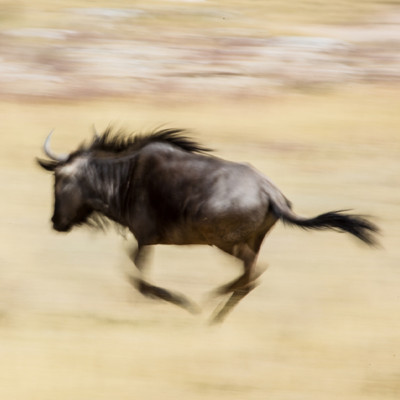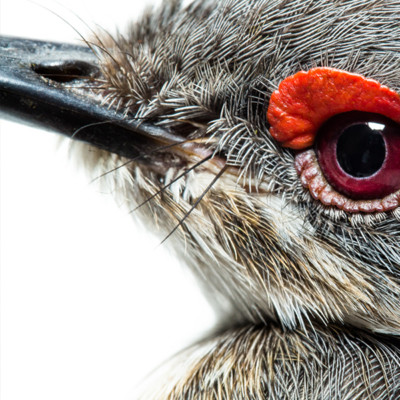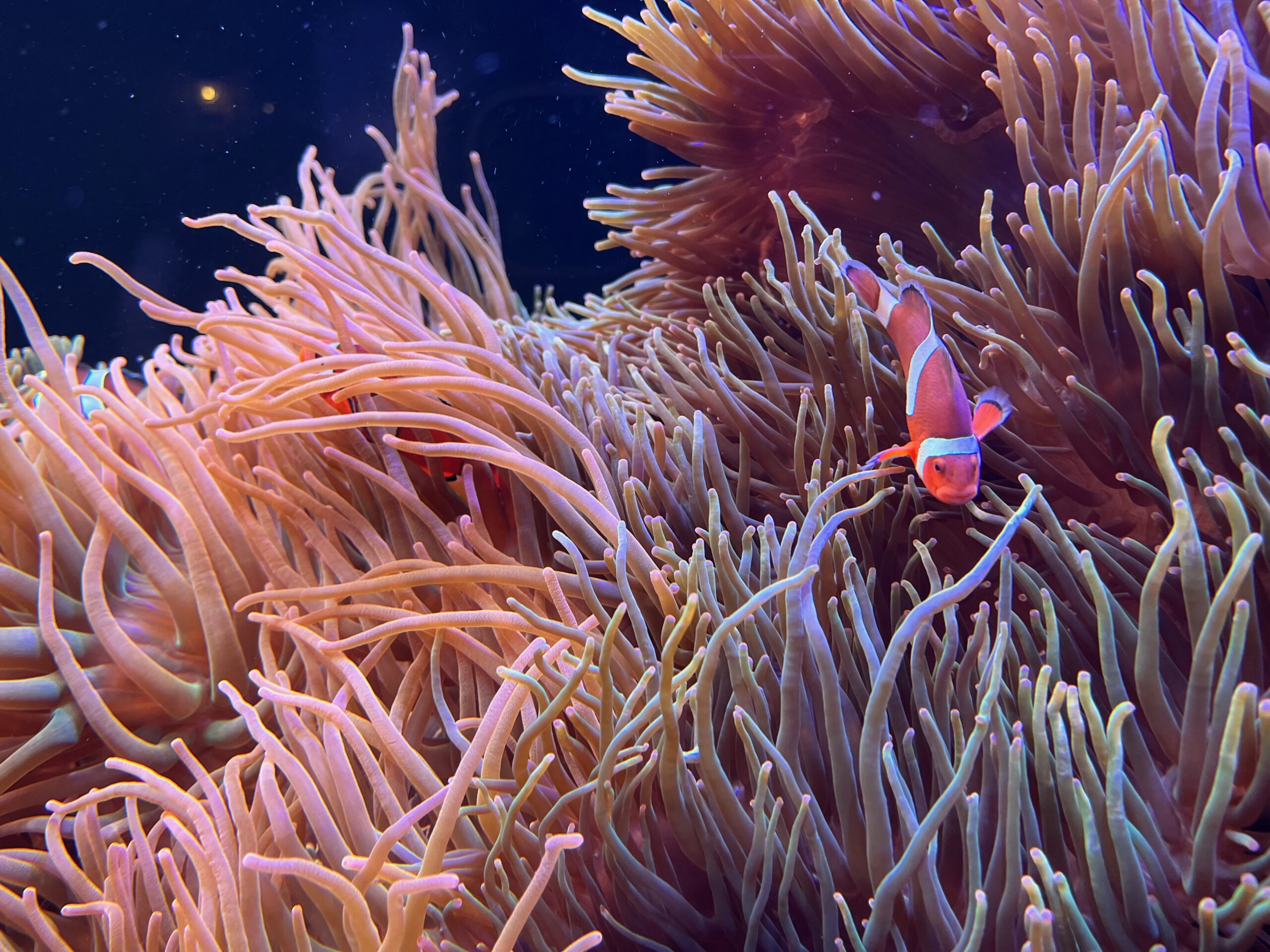
We all can emulate nature
Projecting a building, an agricultural system for a community or to optimize the use of energy in our houses, nature is the one who will always inspire us to create sustainable development.
Diseño & Biomímesis
Designs in Biomimicry have two alternatives at the moment of being developed
The process begins when you already have a biological model or nature’s principle that you desire to imitate in order to develop a design.
Example: It is known that certain long-leaved trees are capable of absorbing the sun’s energy to convert it into another type of fuel that the body uses for its processes. From the design of these leaves, we began to investigate its natural principles to develop a sustainable design that converts light energy into electricity for rural or urban areas.
It consists of using the principles of nature to solve an existing human design problem.
Example: In places where below zero temperatures are experienced, it is necessary to build houses that use less energy to maintain a comfortable indoor climate. To that end, we review how organisms that live nearby solve the problem of maintaining internal temperature, allowing them to survive. Once the principles behind their strategy are found, these are used to create prototypes or blueprints.
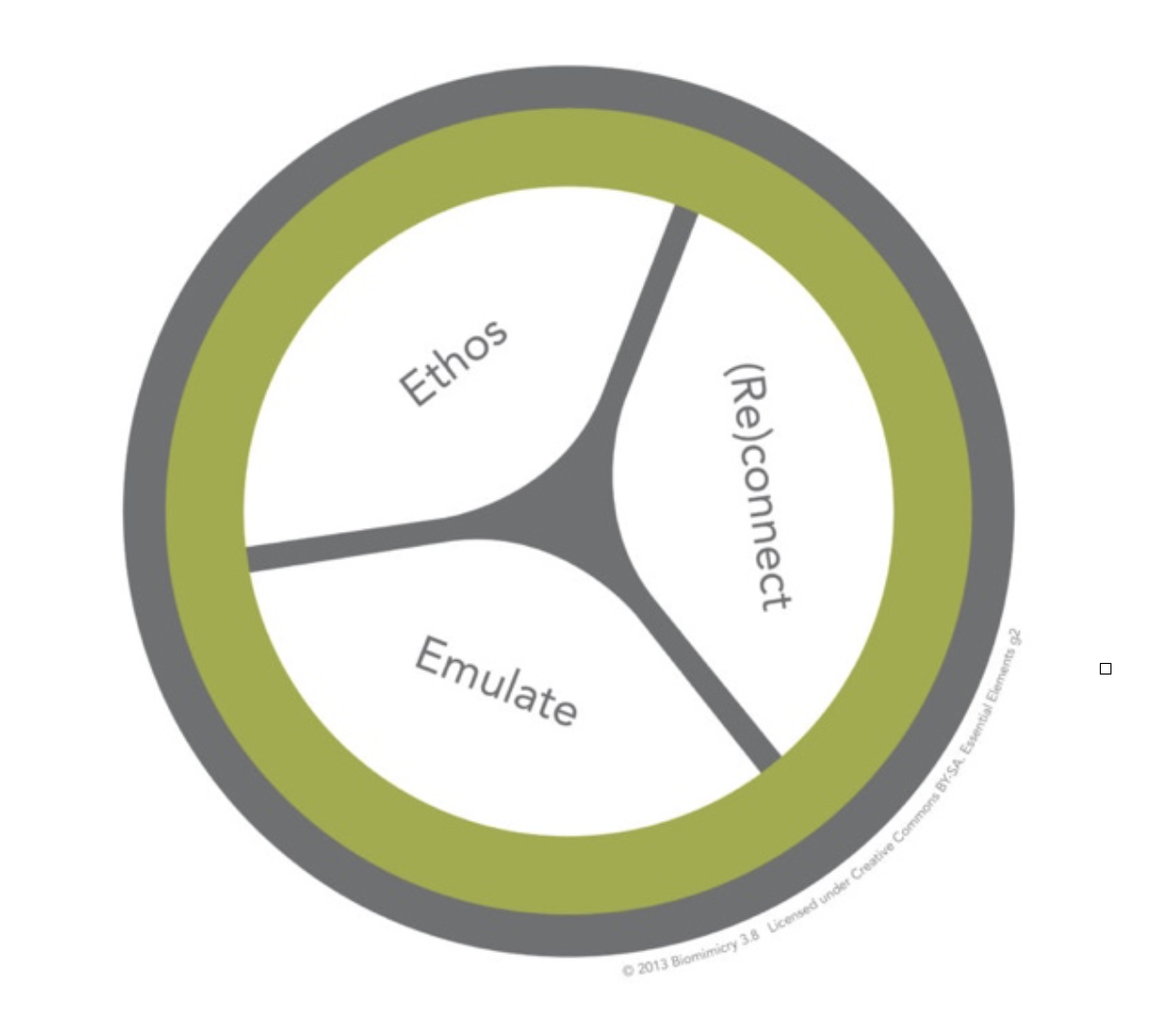
Credits : Biomimicry 3.8. Under license Creative Commons CC-BY-SA
Emulation process
Among the elements of biomimicry this is the most used. During this process we understand the needs of the design we want to build and the necessary conditions for its existence. One of the most important steps is to understand what we want our design to do (its function). Additionally, we decide which principles of nature we want to incorporate.
In the discovery phase, we enter the heart of emulation, in which we look for organisms that perform analogous or similar functions to the design we desire.During the process, we also abstract the biological strategies that allow us to emulate nature. Much of the success of this section is fully understanding how the selected organism performs that role and under what context.
Once understood, the creation phase allows us to properly emulate the deepest designs and generate prototypes from there taking into account the previous steps. Finally, once the best option is selected, we carry out an evaluation using the same principles of nature and thus verify that we have carried out an adequate emulation process.

Credits : Biomimicry 3.8. Under license Creative Commons CC-BY-SA
Scope
Discovering
Creation
Evaluation
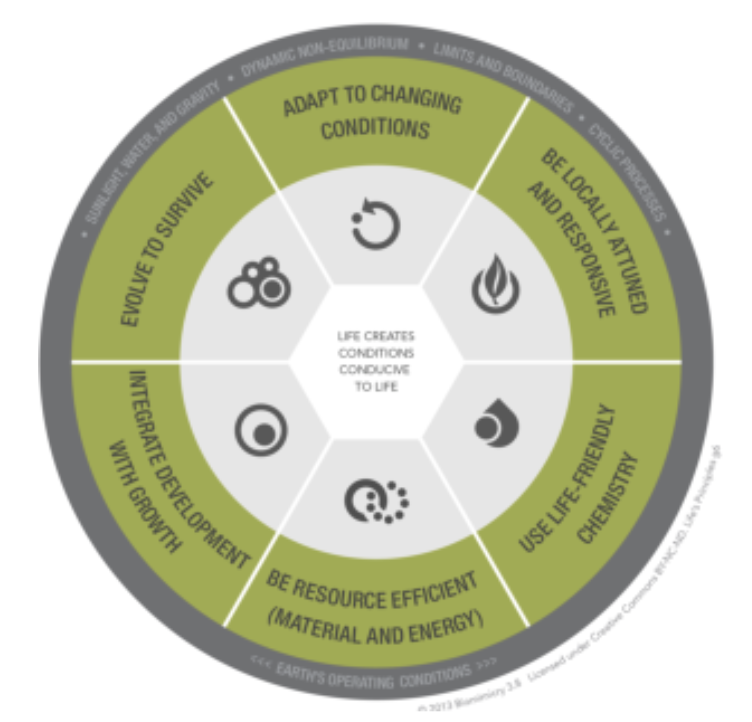
Credits : Biomimicry 3.8. Under license Creative Commons CC-BY-SA
Life’s principles
Although it is impossible to imitate nature 100%, we can be inspired by it to improve designs based on its principles.
It refers to the conditions necessary for life on Earth. Any design inspired by nature must, to some extent, take into account these aspects:
Sunlight, gravity and water: All organisms are subject, directly or indirectly, to the energy produced by the sun and transferred through plants and bacteria. Likewise, they are all affected by gravitational forces. On the other hand, processes that occur in the living are based on water.
Non-equilibrium dynamics: Conditions on earth are changing. In some periods of time, the conditions are stable, but truly, this state of equilibrium is rarely long-lasting. The change in the amount of water in the air or the movements of the Earth, among others, are some of the processes that contribute to this loss of balance. In either case, whether under stable conditions or not, organisms always present responses to adapt to a new stable state.
Limits and boundaries: Life is subject to physical and chemical laws such as the conservation of energy, mass, momentum, Newton’s laws of motion and thermodynamics. These conditions limit and produce boundaries on what organisms can do, produce or develop within the planet.
Cyclical processes: Organisms are subject to solar and lunar cycles, and in turn, to compounds vital for their existence such as nitrogen, carbon, hydrogen, oxygen and water. In this aspect, organisms adapt in space and time to their abundance or shortage.
Respond to dynamic contexts
All organisms face changes that occur during the day, as well as during the seasons and even throughout the years. They must adapt to these new contexts that can be dynamic or stable for long periods of time. In the first case, the flexibility of their functions allows them to survive the new condition by adapting quickly. Once the previous condition is restored, the organism returns to its initial condition. In the second, it is possible that only through several generations some members of a population acquire genetic changes that allow them to survive in the new context. This principle is one of the fundamental bases of the theory of evolution.
Example in nature: Depending on the time of year or day, certain plants adapt to the amount of light, thus orienting their flowers and stems towards the position of the sun in the sky. This phenomenon called heliotropism is used by organisms like daisies, which use their motor cells under the flowers to change their orientation throughout the day and the season.
Example in human design: Land Rover® has designed cars that are capable of driving on any type of terrain. In recent decades, they have created a system called Terrain Response that allows the driver to select various settings, adapting the car to different conditions. In mud and ruts mode,the air suspension will be raised and the traction control system will precisely control the traction on the wheels to prevent slipping on muddy terrain, for instance.
Adjust and/or integrate with the surrounding environment
One of the most powerful tools organisms have is a feedback system that occurs between their exterior and interior. External signals such as temperature changes or the presence of a predator (signal) are captured through a reception system (antenna) located on the border between the environment and its interior (through the skin or ears, for example). According to the information obtained, the body generates a response to that stimulus. This antenna-signal-response, cycle is especially important in this principle, upon which an organism uses information from the environment to survive. Accordingly, response strategies to external stimuli must be aligned with local conditions. They can be short-term, modifying their behaviour or generating a physico-chemical response to the stimulus or long-term, modifying genetics to produce better strategies. This principle invites you to tune in to the closest conditions and not be dependent on signals far from local contexts.
Example in nature: Big monks, found in the moors of the tropical zone in the Andes mountain range, give us a good example of this principle. Temperatures in the mornings and at certain times of the year are low and in combination with low pressures are capable of freezing water. Some plant tissues by storing large amounts of water are at risk of freezing their structures too. To prevent this, the plant is capable of sensing low temperatures and responding adequately by causing the body to increase carbohydrate’s concentration in those tissues avoiding crystal formation, preventing freezing.
Example in human design: There is a group of smart sensors made of flexible crystals that respond to physical and chemical stimuli. These crystals are, in turn, shaped similar to the structures found in butterflies and peacocks. In their primary state, these devices are green in color, but when local stimuli such as heating or stress deform the structure, the color changes to blue or even transparent. The color change is totally reversible once the initial condition returns to its usual state.
Source: https://asknature.org/innovation/intricate-sensors-inspired-by-butterflies-peacocks-and-beetles/
Using the chemistry that makes life possible
Much of the chemistry that makes life possible is based on carbon, nitrogen, oxygen, and hydrogen. Nature also chooses selectively other chemical elements that are necessary in small quantities. The latter will be used when needed.
Such is the case of toxins, which are useful for organisms at some point but must be discarded at others. Instead of using different elements, living beings are composed of structures that are elegantly assembled to perform a function, such as support, transport, communication, among others. These elements are within the group we call chemically friendly, which can also be reused in a variety of ways. This principle invites us to the skillful and creative use of compounds that help us conserve the planet ecologically.
Example in nature: Hemoglobin is the chemical compound in charge of transporting oxygen in vertebrates to their gas exchange organs through the blood and evacuating the carbon dioxide effluent from different metabolic processes within tissues and to a microscopic level, inside your cells. This compound perfectly represents the principle: Most of its composition is carbon, nitrogen and oxygen with the addition of iron, responsible for the effective transport of the mentioned compounds. Thus, we see how nature uses certain elements when it is strictly necessary to perform a function.
Example in human design: The Swedish company Deflamo AB® specializes in flame retardant chemicals (flames) under the brand name Apryium®. These chemical compounds have the advantage of being biodegradable and water based, making them compatible with different materials like glues, suspensions. It can be used to impregnate materials such as polyester, polyurethane and cellulose.
Be efficient in the use of material and energy resources. It’s about taking advantage of resources and opportunities wisely.
Nature uses material and intangible resources (energy and information) efficiently in the pursuit of minimizing their use. Consequently, it does not generate waste when producing or generating a structure, tissue or organ. Therefore, designs made by man should not generate material and energy waste, heading towards the path of a sustainable architecture and economy. However, it is important to highlight that the lower use of resources should not affect a lower performance of a function. This principle invites us to maximize our creativity in the sustainable design of products and services through the use of the least amount of resources without compromising functionality.
Example in nature: The sand crab is a great example of proper use of resources: They use their long antennae to wash their anterior part through passive strain waves, minimizing the use of energy. Its oval shape and strong appendages facilitates digging under the sand. After a wave has passed, it unfolds its antennae in the swaying water, allowing a fine setose mesh to trap bacteria, protists and phytoplankton, causing the same antennae to sweep up the food gathered and take it to the mouth.
Example in human design: The car painting process has historically been energy intensive. Recently, PPG®, a world leader in this industry, has developed a process in which the energy savings are approximately 30% compared to the conventional process. Additionally, it reduces emissions of carbon and toxic volatile compounds by 43% and 7% respectively. The process uses lower furnace temperatures (40ºC difference), and lower residual heat, fresh air demands and faster reaction times. Its researchers have also investigated chemical pathways that require less energy to produce.
Invest skilfully in strategies that promote both development and growth
Growth in nature is necessary, especially in those organisms that are multicellular (fungi, plants and animals), requiring precise coordination for the formation of different structures. For this, it is necessary that during their construction there is a balance between growth and development. The latter is the investment we make in such infrastructure in order to create a platform on which growth can occur. As mentioned by Dayna Baumeister (2014),integrating development with growth adds a stable and contextualized foundation before each phase and reduces the chances of creating chaotic growth. This principle fosters optimization of growth over maximization.
Example in nature: How can a single cell be able to produce a completely new body?The process of animal development is one of the greatest wonders of life, where development and growth integrates. Morphogenesis is the process whereby an organism develops a definite shape. The embryo undergoes sequential divisions up to a point where a pattern is created: some cells receive certain signals while others capture different cues. The aftermath is that some cells become specific for a certain part of the body. For example, an embryological layer in vertebrate animals called the ectoderm will create the types of cells that make up the nervous system, such as motor neurons. To achieve such coordination, the developmental program uses specific rules such as gene activation or repression and gradients, among other strategies.
Example in human design: We hardly decide on urban issues as citizens. This is one of the axioms of the Juicio Ciudadano in Uruguay. It emphasizes that citizen’s opinion is important and should be part of the decision-making process on critical issues, as performed in Denmark. Normally, we have adopted a top-down approach where state institutions decide on political, economic, legal and social matters under the assumption that the experts on those matters will give the best possible decision. However, on different occasions this is not the case. What the exercise outlines is that citizens meet together with experts who objectively describe the necessary background to make decisions. The meetings are binding, as the state authorities are present and moderate the sessions. After the presentation, citizens from different branches of society vote on the subject discussed, carrying out the process in reverse, that is, from the bottom up. In this way, it is ensured that the country’s growth flows along with its development within a realistic framework.
Incorporate information to strengthen long-term performance.
Evolution is a process through which organisms adapt to the environment where they dwell and to conditions that will only change in the long term. Only organisms capable of overcoming a particular situation will be able to survive within a population. Internally, each one possesses information in its genetic material that determines their success. Mutations, recombination that occurs during reproduction or evolutionary processes, will ultimately determine if the genetic material changes, allowing its evolution and coexistence with the surrounding environment. This principle invites us to make changes necessary to survive in the long term.
Example in nature: The origin of photosynthesis is one of the most important events in natural history. How was this accomplished?In times before the flourishing of the plant kingdom, it was common for animal cells to engulf other organisms for food, such as bacteria. But at some point an “error” occurred. Green bacteria survived inside these cells, forming a partnership between organisms. Today we call this society chloroplasts.This endosymbiotic theory has been proven by different scientists. The creation of a cell that could reproduce sexually and carry out photosynthesis allowed plants to colonize the earth and green the planet. In short, this new organism evolved for conditions that were not yet present on earth but developed over time.
Example in human design: After World War II, many economies were fragile and with a significant probability of failure. A group of countries called the Asian Tigers – South Korea, Hong Kong, Taiwan, Japan, Singapore, Malaysia, and Indonesia -decided to independently evolve and create sustainable economies. They devised a flexible long-term plan that incorporated new elements for their prosperity and performance. To survive in the global context, they used the following strategies: First, a stable business environment was established, notably respecting property rights, lowering inflation to encourage long-term investment, keeping public spending low and with high savings rates. Second, investing in people was a key strategy. Educational standards were staggering, with a large proportion of people graduating from high school in Japan and Korea. Third, they embraced international trade creating conditions prone for export. Overall, these elements helped accelerate industrialization and diversify each economy. The net result is seven countries that have had fluid economies for more than three decades.




